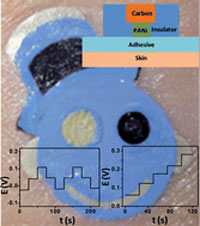| Dec 03, 2012 | |
Medical sensor "tattoo" detects metabolic problems |
|
| (Nanowerk News) A medical sensor that attaches to the skin like a temporary tattoo could make it easier for doctors to detect metabolic problems in patients and for coaches to fine-tune athletes’ training routines. And the entire sensor comes in a thin, flexible package shaped like a smiley face ("Tattoo-based potentiometric ion-selective sensors for epidermal pH monitoring "). | |
 “We wanted a design that could conceal the electrodes,” says Vinci Hung, a PhD candidate in the Department of Physical & Environmental Sciences at UTSC, who helped create the new sensor. “We also wanted to showcase the variety of designs that can be accomplished with this fabrication technique.” The new tattoo-based solid-contact ion-selective electrode (ISE) is made using standard screen printing techniques and commercially available transfer tattoo paper, the same kind of paper that usually carries tattoos of Spiderman or Disney princesses. In the case of the sensor, the “eyes” function as the working and reference electrodes, and the “ears” are contacts for a measurement device to connect to. Hung contributed to the work while in the lab of Joseph Wang, a distinguished professor at the University of California San Diego. She worked there for six months earlier this year under the Michael Smith Foreign Study supplement from NSERC. |
|
| “It was a wonderful opportunity,” Hung said. She worked directly with Wang, who is well-known for his innovations in the field of nanoengineering and is a pioneer in biosensor technology. | |
| The sensor she helped make can detect changes in the skin’s pH levels in response to metabolic stress from exertion. Similar devices, called ion-selective electrodes (ISEs), are already used by medical researchers and athletic trainers. They can give clues to underlying metabolic diseases such as Addison’s disease, or simply signal whether an athlete is fatigued or dehydrated during training. The devices are also useful in the cosmetics industry for monitoring skin secretions. | |
| But existing devices can be bulky, or hard to keep adhered to sweating skin. The new tattoo-based sensor stayed in place during tests, and continued to work even when the people wearing them were exercising and sweating extensively. The tattoos were applied in a similar way to regular transfer tattoos, right down to using a paper towel soaked in warm water to remove the base paper. | |
| To make the sensors, Hung and her colleagues used a standard screen printer to lay down consecutive layers of silver, carbon fiber-modified carbon and insulator inks, followed by electropolymerization of aniline to complete the sensing surface. | |
| By using different sensing materials, the tattoos can also be modified to detect other components of sweat, such as sodium, potassium or magnesium, all of which are of potential interest to researchers in medicine and cosmetology. |
| Source: University of Toronto |
